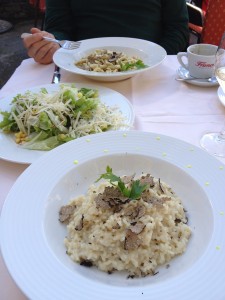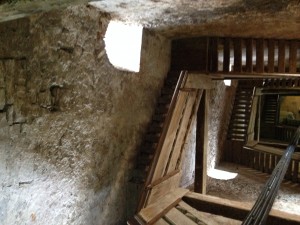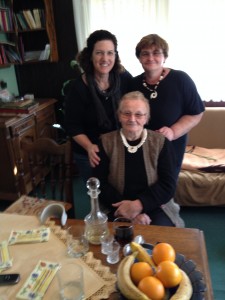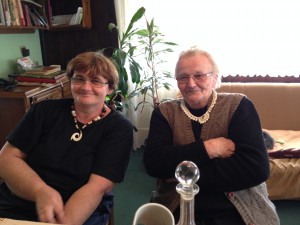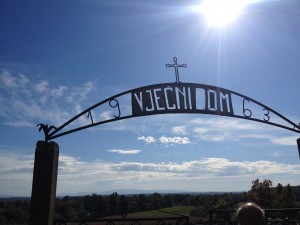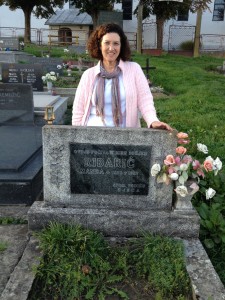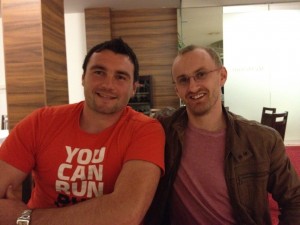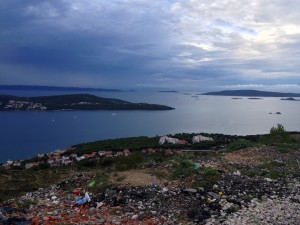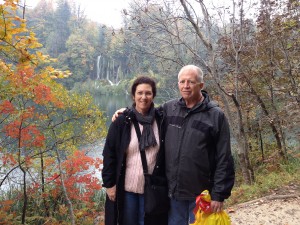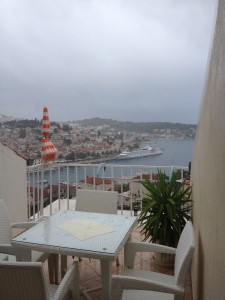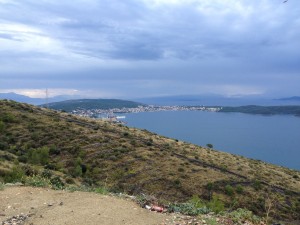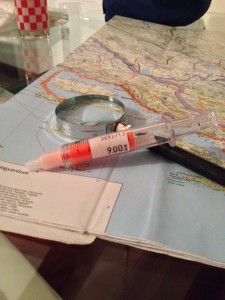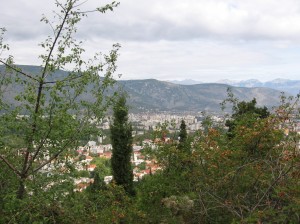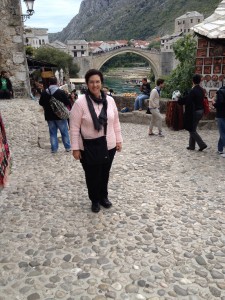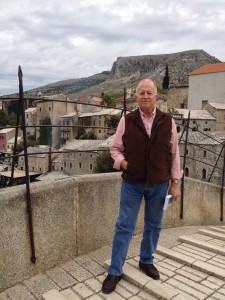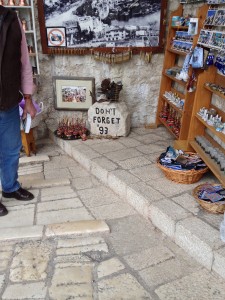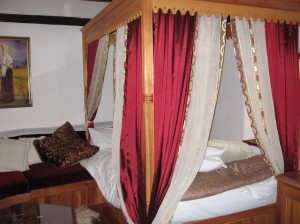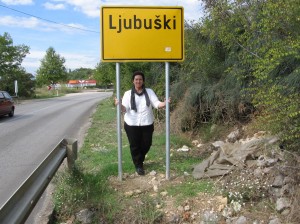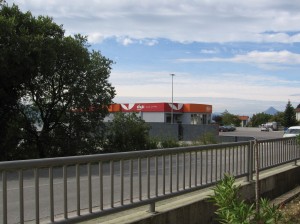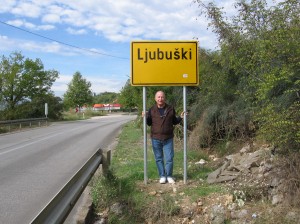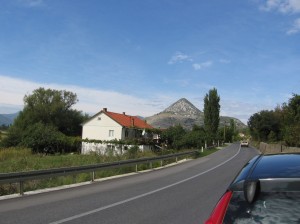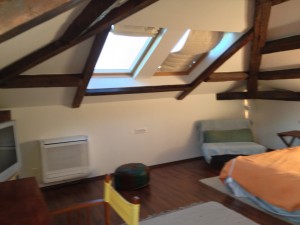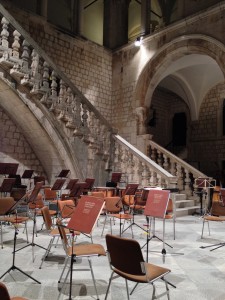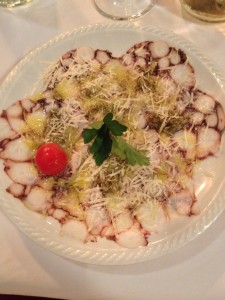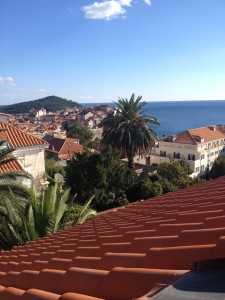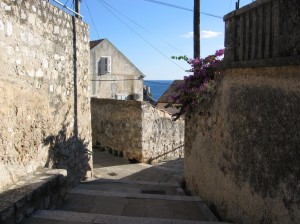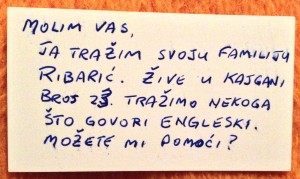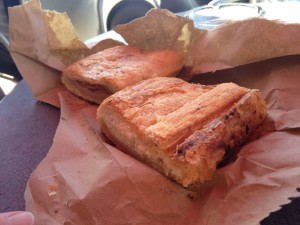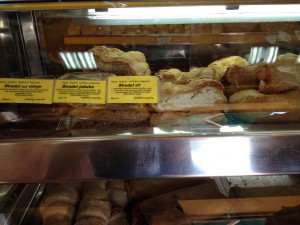I’m a terrible, terrible person for not finishing my story about our trip to Croatia. We had two more stops to report (Ljubjana, Slovenia and Zagreb, Croatia), but it’s so easy to get pulled back into everyday life when you return. I hope to write more this weekend, but I want to give you a little taste of the fun we are having getting to know our Croatian family now that we have found them! My cousins Domagoj and Ivan are great Internet users, so they’ve been keeping us posted with family news. Here is a link to some pictures Domagoj sent me from Kajgana. More to come – and so much more to tell!
Category Archives: Croatia
Rovinj
I’ll write much more about our Kajgana experience in a trip addendum – it’s so different than the rest of our trip – but let me catch up on a few stops we’ve had since, before I go back for the deeper dive regarding my family.
Following a wonderful two days in Garesnica and Kajgana, Mike and I bid farewell – more accurately, “until we return” – to our Croatian family and headed west back to the coast. Our excellent travel agency had selected the key sites for the full flavor of Croatia which must include the peninsula of Istria in the north Adriatic. The drive from Garesnica to the town of Rovinj takes about 4-5 hours, skirts the southern tip of Zagreb midway, rises to 3,000 feet as it tunnels through mountains touching the edge of Slovenia (Croatians do love their tunnels), glimpses the Mediterranean at the town of Rijeka, passes through vineyards then opens to the Adriatic Sea. Not too shabby a way to spend a day’s drive. We took the opportunity to swing by the Zagreb airport to locate exactly where we’d be dropping off our rental car at the end of our visit, time well spent as the drop-off spot wasn’t immediately apparent and required a quick trip into the terminal to speak to a rental car representative. We took our time on the drive, as much to decompress from the excitement of the last few days as to enjoy the change in scenery.
Port of Rovinj
Rovinj is yet another historic port town, though its proximity to Italy lends it a cosmopolitan air not apparent in Dubrovnik, Hvar or Trogir. Our GPS came through with flying colors this time, guiding us directly to Villa Dobrovac and into the hands of Natalina, our host for our 3-night stay. It’s hard to describe what Villa Dobrovac is – not a hotel, as the reception desk is not regularly manned, not an apartment, as we did not have our own kitchen – the closest description is a bed and breakfast, though that minimizes the elegance, comfort and experience of this lovely villa. Natalina – our beautiful and elegant, multi-lingual, informative host runs the accommodations which feel like an elegantly restored (have I used the word “elegant” enough?) Tuscan home. She uses phrases like “welcome to our home” while checking us in to a room with an extraordinary view of the Rovinj port and Adriatric beyond. Natalina’s mother and mother-in-law both live with her and her husband; their children are grown and now live in Zagreb. The family owns fields just 10 minutes drive away where they grow grapes for their wine and vegetables to sell at the stand outside the villa. It’s not easy to describe this amazing woman who could both grace the cover of a European fashion magazine, debate politics (it was a very interesting experience to be an American in Europe during the U.S. federal government shutdown), and check in the grapes delivery that arrived by tractor. One of our most noteworthy discussions with Natalina is her opinion – which we shared – regarding a universal loss of family values, honoring and respecting our elders, making time for family celebrations, taking time to enjoy the simple pleasures of life. These conversations were friendly, open, and invigorating, and made our visit to Rovinj all the more pleasurable.
View from our balcony at Villa Dubrovac, Rovinj
It was at Natalina’s suggestion that we spent a day travelling through Istria, driving up through the vineyards that rival Italy’s, and on to the – hold on to your hats! – Tartuffa (truffle) festival in the town of Livade. Istria is a region that honors truffles (NOT the chocolate variety) as the gems that they are. Once per year the town of Livade, where the Guinness Book of World Records –verified largest truffle ever was discovered. Mike and I had an amazing (superlative deserved) truffle-infused lunch at the hilltop town of Motovun before heading down to Livade below to admire the award-winning gigantor truffle behind glass. I was seduced into buying some local olive oil in one of the Tartuffo Festival tents, and bought some bargain truffles at a panoramic overview at the side of the road. We simply had a flavor of the Istrian peninsula, and what a flavor it is. The pungent taste of excellent truffles certainly brings a distinctive flavor to whatever dish it enhances.
Motovun truffle risotto
We had the great good fortune of meeting a delightful Canadian couple, Barb and Joe, whose stay exactly coincided with ours. We spent our days exploring the lovely historic port town together, and were happy to see that the town retains much of its integrity as a fishing port, in spite of the occasional cruise ship docking for the night. My biggest indulgence for this entire trip was the purchase of a 1940s Austrian crystal decanter and set of 6 shot glasses for the homemade Slivotica I was gifted in Kajgana (oops, dang, I haven’t described that yet) from a small antiques shop high up a hilly road in Rovinj. Of course we have promised Joe and Barb that we will come visit them in eastern Canada, and we then each set off for the next stage of our Croatian adventure.
Hilly streets of Rovinj
My greatest travel joy, bar none, is the people we meet. The world is full of amazing, interesting, beautiful, and kind people.
Oh yes, speaking of the kindness of others – one more thing – I have not yet mentioned my new role in our family, that of designated-bell-tower-climber. MikeLohnes begs off any part of this responsibility, claiming dispensation via his artificial knee and back-surgery experience. I, therefore, have taken it upon myself to climb, on behalf of our family, any bell tower that enters our sphere of experience. As I gloatingly left him at the base of the tower, Mr. Lohnes (knowingly, I believe) neglected to point out that I was proceeding to climb the Rovinj Church of St. Euphemia bell tower at 11:55 a.m. and would reach the summit at precisely noon, when the bells would initiate, in all their glory, their most magnificent and lengthy chorus of chords and chimes. When our friends Joe and Barb happened upon him at the base, and asked if I’d really climbed the tower, Joe told Mike he suspected I’d require and increased volume of conversation over the next few days – they were right. I’ve captured the bell-chiming experience in a video which I will upload as soon as I have better Internet connectivity.
MikeLohnes sitting on bench below bell tower
View of the rickety wooden bell tower steps upon which Maggie Lohnes risked her life
Part 2: Your Family is Waiting for You
I left out so much of the story of meeting my Croatian relatives. Here are a few more vignettes – more to come when we get home:
Click here for my video introduction to Kajgana
Nada and Kata with their new Maui necklaces (more on that story later)
Gateway to church cemetery where my relatives are buried, the words mean something like “Forever Home.”
Your Family is Waiting for You
Thanks for your patience. The lull in my writing results from the difficulty I’ve had putting into words the experience of the last week or so. Following our attempts to find evidence of my grandfather’s early life and any of his family’s descendants in Klobuk, Herzegovina, our attention turned to retracing the steps of my grandmother, Kata Ribaric Dzaich, in central Croatia. I did not have much to go by, other than a copy of her birth certificate indicating she had been born at home to Manda Trkac and Ivan Ribaric who resided at 23 Kajgana near the town of Garesnica, in what was then Austria-Hungary. From her Ellis Island immigration records, we knew that Grandma arrived in the U.S. in 1918, and we had some old grainy family photos from my grandmother’s one visit back in the 1970s. My sister Katherine and her husband, Don, had also visited in the 1980s, before the Yugoslav wars, but the one relative they knew who spoke English had long passed away.
At the bewilderment of our travel agent (btw, the Jay-Way is an exceptional agency for helping Americans navigate Croatia), we insisted on booking two nights in the small town of Garesnica. We’d explained that my grandmother came from the small farming village of Kajgana, and Garesnica is the closest town with any commerce to speak of, just a 3-5 minute drive away. The Hotel Garic is apparently the only game in town for an overnight stay, so there we were to stay. I had an idea that we might be able to find a translator among the hotel staff and had been planning to call ahead to inquire, but for some reason kept putting it off. I suspect I was afraid of the disappointment should I reach a dead end.
For some reason, as we were on the ferry from Split to Hvar, I suddenly felt the time was right to call Hotel Garic and explain my situation. The man who answered the phone quickly turned me over to a coworker, Christina, who spoke perfect English. I told Christine I was looking for someone who could help me find the family of Kata Ribaric, last known address 23 Kajgana. I explained that I suspected that any remaining family members would not speak English, and I did not want to knock on a door without a translator who could explain who we were. Christina listened carefully then said, “I will ask my mother she knows everyone.” She ended the call with a common Croatian saying “It’s not a problem,” then said she will see us when we arrived later that week.
Thursday October 10th Mike and I departed the Plitvice Lakes region to head northeast to central Croatia. The drive of approximately three hours was interrupted once as we were pulled over by the Croatian police who took about 15 minutes to review our passports, consult with each other (I deciphered the words “iPhone” and “GPS”) before deciding we were free to go on. We had told Christina we expected to arrive in Garesnica by about 2pm, and we pulled up to Hotel Garic with 10 minutes to spare. As we walked up to the reception desk, I asked the friendly clerk if she were Christina, she nodded yes. She greeted us warmly then smiled and said:
“Your family is waiting for you.”
Pause. I gulped, looked at Mike, then back to Christina, and said, “Now?” She said yes, it was easy, as she suspected, her mother knew exactly who to contact. Coincidentally, the wife of my grandmother’s nephew was also named Kata Ribaric, and lived with her daughter Nada (formerly Ribaric) and son-in-law Jovica Potrebic. The only correction is the address – they live at 60 Kajgana, and one of them speaks English. They were waiting for us. She would call and tell them we had arrived, would take some time to freshen up, then come visit. Christina smiled and said “Are you happy?” Of course I was – happy and a little stunned.
As Mike and I drove the 5 minutes to Kajgana we noticed what we think were a few spotters along the way. Pulling up to 60 Kajgana, three people were already coming out to the front to greet us, waving us in through their gate. We popped out of the car to give each a big hug and they brought us in side. Jovica explained he learned English from the radio – we think he said he had some kind of radio show, not ham radio, and through that he learned English. We spent the next couple of hours going through the pictures I had brought, I explained how we were related, they recognized many of the old photos and explained who was who. That afternoon and the following full day were spent in warm and comfortable conversation. I have many, many stories to tell about our time together, but I’m still processing it all and will add more later.
Kata, Nada, Manda (me) and Jovica on the farm
At my great-grandmother’s grave
An additional treat was meeting Nada’s son, Domagoj, and nephew, Ivan, the son of her sister, Mira, late on our last evening as they returned from their week’s work in Zagreb. They are delightful young men and we expect to meet them again on our last day when we are in Zagreb before our return to the U.S.
Ivan and Domagoj
I have told Mike how unexpectedly comfortable I have felt in Croatia, how easy the language rolls off my tongue, how familiar the landscape of central Croatia feels. Now I know why.
Plitvice Lakes National Park
On Wednesday Mike and I left the central Croatian coast behind in a rented white and blue VW and headed north up the A1 highway into the Balkan mountain range. Plitvika Jezera – Plitvice Lakes – is Croatia’s largest national park, about a 2 hour drive from the seaside with absolutely stunning views along the way. We continue to note the terrific condition of the Croatian road system, and the clearly significant investment Croatia is making in its infrastructure. The road signage is clear, and the GPS is dependable here. These imposing granite mountains must have been quite the obstacle without the series of relatively new (last 20 years) tunnels, and the Sveti Rok tunnel at 3.5 miles is the longest either one of us had travelled through.
Road leaving Trogir into the mountains
Much as I loved the brilliant beauty of the coast, the farther I got into the mountains the more I felt that we were approaching the “real” Croatia I had heard of throughout my life. I suspect these central mountains resemble those of Switzerland or Austria, being dotted with more rustic homes with picturesque farms, and roads running off to the east or west to little towns. It is in this area where the town of Mrkopalj exists as highlighted in the excellent book “Running Away to Home.”
We arrived at the Plitvice Lakes parking lot 2, were waved towards the automated parking ticket dispenser, and found a parking spot under the trees. Written reviews of the Plitvice Lakes note its beauty but lack of “crowd control” which, at this time of year (off-season), seemed more to do with the cryptic signage. Were the parking lot full of tour buses, I can imagine it would be very confusing. We spotted the “Turist Buri” and went in to purchase a ticket. There were 5 employees around the desk, but all guests were queued up at the one dispensing tickets. The other 4 wouldn’t make eye contact and seemed slotted for certain unneeded services such as money exchange. One finally did explain to us the signage system – the trails are marked with a system of letters depending on how long a walk you want to take. We selected “E” for the 2-3 hour trek, which meant we picked up a shuttle at Stop 2, were shuttled up to the top at Stop 3, and walked 2 hours somewhat downward until we caught a boat across the lake back to Stop 2.
The park, a series of extraordinary lakes and waterfalls, is unique in its system of elevated wooden walkways throughout. We commented that in America someone would have sued for more safety controls, and there certainly is no handicap access, but for the able-bodied and eagle-eyed tourist, the walk is a fantastic adventure. We kept crossing paths with two sweet Israeli girls with whom we exchanged group-photo requests and so were able to get some Christmas-card-worthy photos of the two of us. The wooden-walkway trek was great for exercising the quads, and we were very glad we did not choose the “C” 5-6 hour route.
After the lakes, we drove about 10 minutes more to our destination for the night, the very lovely Hotel Degenija, the nicest hotel of our trip to date and easily of our recent trips. Our hotel clerk, Mario, resembled our Bobby so much I asked to take a photo, and he and Mike had a lengthy discussion about American basketball and wrestling. Mario is a fan of the Denver Nuggets, a team he chose for the excellence of their jerseys. He gave us an idea of the cost of living in Croatia compared to typical salaries, where the low cost of food is offset by the high cost of petrol that eats up 25% of their salaries. The associated Restaron Degenija was a great value at $59 for the “Mixed grill meat for two” which would have been more appropriately named “Enough meat for a family of six” – the $59 included a full bottle of wine for me, which I corked up and brought back for future consumption.
We highly recommend both the Plitvice Lakes and the Hotel Degenija for any complete tour of Croatia.
Lost in Bosnia – Medjugorje to Hvar and Trogir
Dear Mr. Garmin GPS CEO Sir, With all due respect, you really need to up your game in Bosnia and Herzegovina. It would be most helpful if you would simply indicate “unknown road condition” if you aren’t absolutely certain the road is paved, passable, and not in hostile territory. We suggest starting with the hills between Medjugorje and the Adriatic coast. Best regards, Mike and Maggie Lohnes
Rest assured, all’s well that ends well.
Good Catholics that we are, Mike and I decided we could not leave Bosnia and Herzegovina without a visit to Medjugorje. For the uninitiated, Medjugorje has been a popular pilgrimage site since the 1980s when six local children started seeing apparitions of the Virgin Mary in the local hills. This was not to be missed. To further add to the excitement, we chose a Sunday to park our little Peugeot among the tour buses and see what all the excitement was about. No one seems to have told the thousands of people in hundreds of tour buses parked at the Church of the Virgin Mary that a) the Catholic Church has not officially recognized the visions and b) the church is not where that apparitions are seen. There are many very devout people who are making the trek to Medjugorje, and they all converged on the local church. After taking in the excitement of the church crowd we realized we needed to find Apparition Hill. One of the smaller souvenir stand owners was kind enough to point it out on a map, and we got back into the car and headed into the hills. Apparently we overshot the trailhead of the path to the official site, as we notice the building density start to wane; yet another kind shop owner came out and told us to turn around on the 1-lane road. At this point Mike and I decided that we’d gotten as close as the Virgin Mary meant for us to be, having seen the actual hilltop from a distance, and decided to head to our next destination, Hvar, via Split. We left Medjugorje around 11 a.m., knowing we had plenty of time to make the 4pm ferry from Split to Hvar.
This is when the fun began – probably the Virgin Mary’s retribution for our not having made enough effort to locate Apparition Hill. We were determined to return to the Adriatic coast road, rather than an inland highway through Bosnia, for the trip to Split. As has become our habit, I entered in the name of a town along the route we wished to take, turned off the volume to ignore the incessant “Make a U-Turn” instructions, and we headed across the Bosnian hills. It seemed from the map that the road we’d originally veered off from the coast was “just over there,” but alas, long story short, we found ourselves headed down an unpaved road, passing under an enormous half-built bridge we’d recognized from our trip to Klobuk. At this point things were getting a little dicey, and we decided to turn the GPS volume back on. Our estimated arrival time at Split had just doubled, and we had no idea if we were heading closer or farther from our destination. I recall telling Mike “I think we should be hitting the border soon,” and then breathed a sigh of relief to see the border crossing ahead. I’ve never been so happy to have someone approach our car and demand to see our “documents.” After the official handed back our passports, I took the opportunity to ask “can you show us where we are?” Hearing “Metkovic, 100 kilometers ahead” gave us the orientation we needed to get us back on track. We’ve decided to stick to major Croatian roads for the rest of our journey. We made it to Split at 3:30, just in time to hand off the rental car to the agency, pick up our tickets, and hop the ferry to Hvar.
The two days we spent on the island of Hvar, followed by a night in Trogir, were blustery and wet, but that didn’t keep us from experiencing life in these historic cities with much of their original medieval construction preserved as a UNESCO historic site. We experienced quite an unusual downpour in Trogir, but fortunately the rains waited until I had climbed the bell tower for a full view of the town.
View of Hvar town from our apartment
Hvar port
View of Trogir from highway
Mostar
On my last post we were leaving Klobuk behind and heading to Mostar for the night. I had plotted the trip on Google Maps with a double-check against the road map of Croatia/Bosnia and Herzegovina/Slovenia I purchased in Dubrovnik. [To backtrack with an amusing story, while in Dubrovnik I decided I needed a highlighter pen to identify the route on our paper map. I searched Dubrovnik historic city until I found a bookstore, and almost purchased a pack of four yellow highlighters when ever-thrifty Mike said they had individual pens at the cash register. The attendant said she had only one single highlighter and showed us one that came oddly packaged as a play hypodermic syringe. We decided to buy it as it was cheaper than the four-pack, but I have since been traveling in fear of being pulled over at the Bosnian border for carrying drug paraphernalia :)]
ORANGE HYPODERMIC HIGHLIGHTER
In any event, we left Klobuk in our rear-view mirror guided by a Google Map printout, an orange-highlighted road map, and our GPS. The route continued north through the mountains, turned east at Grude, meandered through Sirokei Brijeg, and came downhill into Mostar. I was surprised at the size of Mostar, very impressive from the hills above.
To be honest, I had no idea what to expect of Mostar, knowing only from a brief TV story that Mostar is the largest city is the Herzegovina region of Bosnia and Herzegovina. I wish I had done my homework ahead of time, because I was unprepared for the cultural initiation I would receive into this extraordinary city. The central and most-visited part is the historic city of hilly streets, paved in unusual rock patterns, and lined by small shops and restaurants. The historical Ottoman influence permeates the air with aromas of spices and music and art. The historic center streets cross the Neretva river by the beautiful Old Bridge (Stari Most) that was recently painstakingly rebuilt after being destroyed in the 1990s war. I learned that the Old Bridge is said to be where East meets West, and one can certainly observe the mix of cultures in the community.
Outside the small historic town, the city of Mostar can only be described as “war torn.” Mostar is the closest I have been to the evidence of war, with bombed out buildings covered in street art, roads yet to be repaired, mortar holes in the sides of homes. At our hotel we met a young couple from the U.S. who were only their honeymoon. The wife spoke Polish and so could read some of the graffiti on the buildings. She said one of them read “Is Freedom Worth It?” It is so hard for us Americans to fathom making a decision between freedom and prosperity.
We stayed one night at a lovely hotel, the Muslibegovic House which is actually a Bosnian National Monument, having been a former wealthy Ottoman home. Inside its walls is a lovely courtyard and comfortable rooms with Turkish beds. At breakfast Mike declared the coffee was the best he’d ever had, I’m certain it was Turkish coffee, and it was at the very least the best we’ve had this trip.
Our hotel host was kind enough to help map our way out of town (she declined to use the syringe-highlighter, however), and in short order we were on our way to our next stop, Medjugorje. I wish I’d had more time to explore Mostar and take a “deeper dive” in, and hope to return one day.
Klobuk
Today was a very long time coming. One impetus for this trip is a quest to discover my maternal Croatian roots. In 1907 my mom’s 19-year-old father, Jozo Dzaic, left his home in Klobuk, then-Austria, for the long trip through Ellis Island to America. There, as Joseph Dzaich, he started his restaurant business, married Kata Ribaric from Kajgana, and raised 6 children. Joseph never returned to Klobuk, and no other family member has ever been there….until today. I wanted to see where he came from and discover any evidence of the family he left behind.
I spent some time in the days prior to this day plotting our route to Klobuk. Google Maps is extraordinary in its knowledge of the networks of roads in the most remote areas; its ability to discern the quality of those roads is not completely perfected. The first route Google Maps suggested was to head straight over the mountains from Dubrovnik, and, once over them, venture north. Fortunately, as the 19-year old attendant at the Internet cafe handed me the route print-out, he commented “you know, Bosnian roads are not so good.” He then sat with me and helped plot a route up the coast on the M-6 (he called it the Adriatic road) to Opuzen, turn east on the M-9, cross the Bosnian border at Metkovic, turn north on the M-6 through Ljubuski to Klobuk. We also took time to research how we would leave Klobuk and get to our overnight destination in Mostar. My new friend wished me well, thanked me for the tip I gave, and went back to his pizza. Thank goodness for the kindness of strangers.
Saturday morning Mike and I left Dubrovnik in nice little rented Peugeot and headed up the Adriatic coast. The beauty of the Croatian coast with its hundreds of island is well known, but what we were struck with is the spectacular clear blue skies and waters. It looks to be completely unpolluted, crystal clear and clean. The southern Croatia coast is a narrow strip of land flanked by tall mountains, on the other side of which is known since the 1990s as the country of Bosnia and Herzegovina. The geographic demarcation is clear; those mountains are extremely domineering and certainly nearly impassable in most areas, and the coast is the jackpot of scenery, seafood and access to the outside world. No wonder so many wars have been fought to gain control of this strip of land. Interestingly, Bosnia and Herzegovina’s border does hit the coast for what seems like no more than a 10-mile section, and we needed to provide our passports as we crossed through.
To supplement our Google Maps route printout, our Garmin GPS, fully updated with the latest European maps, succeeded in locating Klobuk. We found the GPS most useful for noting your current location, tracking your car on the map, though we had to turn off the volume as its constant suggestions to “make a u-turn” or to turn off onto a mountain road became frequent and annoying. There is a clear distinction in road maintenance and quality between Croatia and Bosnia & Herzegovina, although the Bosnian highways were safe and navigable. As we reached Lujubuski, a large city in a plain below Klobuk, we noted a large market with the name “Dzajic” emblazoned on the side, and stopped to snap a photo, and continued into the hills toward Klobuk. My grandfather had indicated “Ljubuski” as his birthplace on his American Intent to Gain Citizenship application, I suspect because it was the largest town with any commerce close to Klobuk. We continued on, but noted for future research, Ljubuski might be the best source of documents.
Our route started gaining elevation as we drove into the hills to Klobuk. Growing up, we had been told the Croatian word “klobuk” means “hat,” and Papa’s village got its name from a distinctive hill. It was very exciting, rounding a bend, to discover the klobuk-shaped hill. We stopped and snapped a photo. Passing the Klobuk road sign, we stopped at the first cemetery we saw to look for names. Mike noted that the cemetery seemed new, all the headstones certainly are. We searched but did not find any Dzaic names, though the location was the perfect spot to shoot a video I had been rehearsing. Here are a couple of snapshots from that area. I’m having difficulty uploading the video to YouTube, and may have to wait until my return to the U.S. It was a very emotional moment for me as I realized I had reached my grandfather’s home town.
KLOBUK MOUNTAIN
We proceeded north along the two-lane highway, looking for homes and people. Passing scatterings of homes in various stages of maintenance, we spotted a church in the distance and drove over. The front doors of St. Mark the Evangelist church were open, and we spotted some people cleaning inside. Parked the car and approached; no one spoke English, but one man was brought forward who asked if we spoke German. Unfortunately, communication was an issue; I showed them the pictures I had brought with me of the 6 young men who came to the U.S. from Klobuk, their names written on the back. I pointed to the word “Dzaic” and raised my hands in question – they shook their heads “no.” Next time I’ll bring my Croatian or German-speaking friends. We looked through the church cemetery for some recognizable names; the closest one we found as “Dzekusic.” We did note that several surnames resemble local towns “Culjak” and “Medjugore” so the tradition of naming families by location seems to continue.
Not one to be easily thwarted in my quest, I noted that several newer model cars had taken a one-land road off the main highway along-side the church into the hillside. I encouraged Mike to follow them, hoping to find friendly, English-speaking folk, and we proceeded across a fairly new wooden bridge to a pretty little area with a few homes. Mike’s public investigator radar was activated when he noted that these new-model cars were actually all late-model Mercedes driven by well-dressed middle-aged Middle-Eastern men, who, in his estimation, were probably packing heat. It was his advice that we skedaddle as quickly as possible (“skedaddle” is my translation for the words he actually used). We noted that yet another Mercedes had crossed the wooden bridge towards us and had pulled over – I thought it was to kindly let us by, but Mike noted he was talking on his cell phone and checking us out. We headed back to the highway and stopped to make one last video – this time with a new spin. This experience leads me to believe that the story we had been told about my grandfather’s educated brother being executed in Klobuk in approximately 1944 was true, and Klobuk has developed to be a haven for some not-so-seemly activity disguised by the rough and remote geography of its hills. I’m hopeful that some day we will learn our assessment is incorrect, but for now, we felt it best to get on to the haven of our next stop, Mostar.
Last Day in Dubrovnik
I have a theory that once you’ve visited a new city for three days you must either leave immediately or stay on for a full week at the least. My rationale is as follows:
Day 1: Get oriented to physical layout and time-zone bearings (can be combined with Day 2 if short on time)
Day 2: Visit the must-see sights, so you can say you did them (e.g., Eiffel Tower in Paris, London Bridge in .. uh.. London, Military Tattoo in Edinburgh, Haleakala volcano at sunrise in Maui, walk the wall of historic Dubrovnik)
Day 3: Scratch the surface of some off-the-beaten path activities
These three days allow you to float about, tread the water, and perhaps stick your face a bit under water to see what lies beneath the surface. After three days, though, you must either leave town or dive in deeply. I’ve had the great good fortune of diving in a few times in my life by renting apartments in residential Paris and Florence, buying and cooking fresh food from the local markets, making friends with the neighbors and feeling like part of the community. This one must do to really get to know a region. If time and resources do not allow, best to tie up the visit with a scratch-below-the-surface kind of day.
Here’s a photo of our little Dubrovnik apartment
Friday was our last day in Dubrovnik, technically day 3, therefore, and as it was scratch-below-the-surface day we started by skipping (OK, walking quickly) to town by a different route WITHOUT needing map in hand. We chose a breakfast restaurant outside the historic city walls, and the eggs on Mike’s plate looked so bright yellow they were about to pop off the plate.
First stop was the Franciscan monastery museum, old pharmacy and church. From the city wall walk the previous day we had a good perspective of the Franciscan monastery from above, and could observe with envy the quiet cloister through its open courtyard. For just a few kuna we were let inside, and sat together enjoying the cool quiet while a few religious quickly walked about us. Curiously, the Franciscans have maintained a pharmacy within their monastery walls; in addition to the modern operating pharmacy, they display the original one, with all kinds of antique medicine bottles and other medical equipment. When I inquired at the gift shop if they had any pictures of the antique pharmacy, I was asked if I were a pharmacist. Although I replied “No, I’m a nurse,” a sweet woman surreptitiously handed me a photo postcard under the table and said “take it.” Click here a link to a photo I found.
From there we moved down the “Strada” to the Dominican monastery, not as busy as its Franciscan brother, most likely due to its distance from the main gate. Hard to imagine this small walled town could house so many religious but I must admit I would mind being cloistered in such a gorgeous place. As we wandered throughout town we noticed that the Dubrovnik Symphony Orchestra would be performing at the Rector’s Palace that evening and decided it would be the perfect end to our Dubrovnik adventure. Below are photos of the amazing octopus carpaccio I had for a pre-concert dinner, as well as a snapshot of the orchestra arrangements from our first-row seats. The concert sold out its approximately 100 seat venue and we noticed some were sitting on the marble steps of the building in order to see. The oboe soloist Thomas Hutchinson from New Zealand couldn’t have been more than 21 years old, and he was extraordinary. No recording can take the place of live music for touching the soul.
On Saturday morning we will be picked up at 8am by a rental car representative and begin our trek up the coast. Going to be an early morning!
[My apologies for the rather brief and abrupt posting. My current Internet connection is very sporadic, and I’m especially having trouble uploading pictures. More to come when I get better connectivity.]
Dubrovnik – first 24 hours
Just passed our first 24 hours in Dubrovnik and have already met a Canadian who was born in the town next to my grandma’s, and a Croatian who spent 10 years living in my hometown, Glendale, California. One thing I love about travelling outside the U.S. is the willingness of people to chat across restaurant tables, so much less guarded and than Americans when it comes to revealing oneself.
We arrived at our “sobe” – rental apartment – Wednesday early afternoon, and were greeted by the owner, Rastko, who introduced himself as “not the owner, the man of the owner” with a grin. He showed us our lovely large apartment with brilliant views of the Adriatic across the old city.
Fortunately we were not as tired after our long trip as we’d expected, so changed quickly into something cooler – bright sun was out– and headed off to explore. Dubrovnik is a hilly town, lots of steps, all leading down to the old city. We made our way down our lovely walk from our sobe, literally 10 minutes down (and later to learn, 30 minutes back :)).
The first commercial enterprise we encountered was a gelato stand just outside the Plini (main) gate. Spotting my hard-to-find favorite, hazelnut, we stopped for a scoop. Tasty enough, but as we’ve unfortunately been spoiled by the amazing gelato in Florence, it did not live up to our exacting standards. They do, however, have the Florentines beat on decor, as evidenced by the Gelato Man statue outside the building
Guide book and map in hand, we headed into the walled city and wandered about to get oriented. Our local agent, Antonia, had told us the walk across the old town from wall to wall takes 10 minutes time; she was quite literally correct. This did not, however, factor in stops to pop into St. Blaise Cathedral during rosary time (patron saint of Dubrovnik and known to cure throat ailments; let’s hope he cures my cough), check out the tchotchkes, or read every posted menu for a potential dinner locale. We’ve discovered the creative charms of friendly restaurant representatives scattered about town, helping you find your way, then very convincingly suggesting the best restaurant with the best prices in town. It was thus that we found ourselves seated for an early dinner at a sidewalk cafe, and my dish certainly lived up to its billing as a fresh Dubrovnik seafood platter – whole grill fish, head and all, tasted magnificent.
In short order, two couples sat down at the adjacent table and looked over to admire our food. When I noted they were also served the same gratis “Croatian antibiotic” (Rakija – an herbal variant of slivovica) we struck up a conversation. These two couples are Canadians who have been travelling together through Croatia for weeks and were about to head over for 3 more weeks in Turkey. Long story short, the husband, Carl, was born in Tomasica, the town immediately adjacent to Kajgana, my grandmother’s village in the north. They had just been to Kajgana (population 300) and showed us some photos. When I told him we were trying to locate relatives in Kajgana, he, noting that they most likely did not speak English, wrote out a message (see below) in Croatian for me to use when I show up there. It says, in essence, “Hello, I’m trying to find relatives from the family Ribaric who lived at 23 Kajgana – does anyone speak English here?”
Needless to say, the combination of our jet lag and two shots of Rakija (I had Mike’s as well as mine) took their toll, and we were home asleep by 8:30pm.
Today, Thursday, started with coffee and pastries at the local coffee spot, and for anyone who was raised with Croatian relatives, having hot cheese and apple gibonica (strudel) is as decadent as one can get.
Our day was spent on the obligatory tourist activities, taking the cable cars to the Homeland War memorial in Fort Imperial on Mount Srđ (the 1991-94 war of independence remains in daily conversation), and walking the historic walls of the Stari Grad (Old City).
Had a light dinner of thin crust pizza and coffee then walked up (getting better, 20 minutes) the stairways to our sobe. After one more night of early sleep, we should be sufficiently time-zone-adjusted, and plan to spend our last full day in Dubrovnik visiting the smaller museums, attending a concert of the Dubrovnik Symphony Orchestra, and dressing up for a late dinner.
Laku noć – good night.


